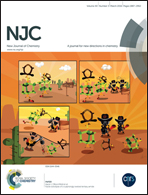A structural, spectroscopic and theoretical study of an o-vanillin Schiff base derivative involved in enol-imine and keto-amine tautomerism†
Abstract
The potassium salt of the Schiff base obtained by condensation of 2-hydroxy-3-methoxybenzaldehyde (o-vanillin) and 2-aminoethanesulfonic acid (taurine) in a methanol potassium hydroxide solution was characterized by crystallographic, spectroscopic and DFT methods. The compound crystallizes in the monoclinic C2/c space group with a = 37.539(4), b = 5.9129(4), c = 26.321(5) Å, β = 121.10(2)° and Z = 8 molecules per unit cell. The crystallographic data reveal that two different anionic molecules, which constitute a tautomeric pair, coexist in the crystal. This finding is supported by FTIR, Raman and electronic measurements in methanol solution. The main crystallographic differences between the bonding structures occur along the shortest chemical path linking the oxygen and the nitrogen atom of the OH and CN group. Both tautomeric forms are stabilized by strong O–H⋯N and N–H⋯O intramolecular hydrogen bonds. Optimized geometrical parameters and calculated spectroscopic features obtained by DFT calculations show a very good agreement with the experimental data. Moreover, 1H NMR, 13C NMR and electronic measurements in DMSO solution show the prevalence of the enol-imine tautomer in this solvent.


 Please wait while we load your content...
Please wait while we load your content...